|
Ain Dara are the ruins of the Aramaic city with ruins of rich temple, decorated with basreliefs with sculptures of lions and sphinxes. It is considered that Hittite temple of the goddess Astarte, is erected on a hill, obviously artificial origin. It was made mound of earth and stone in the middle of a flat valley, which is easily visible from this hill.
Initially, perhaps, the hill had a rectangular shape, but with the passage of time the angles noticeably "floated" and widened. But the orientation preserved and it is clearly seen that this is the diagonal of a square.
|
|
Aspendos theatre is one of the ancient attractions of Turkey, built during the reign of Marcus Aurelius (161-180 AD.), by son of Theodore, the architect of Zeno (Zeno). This building is without doubt outstanding work of Roman architect who managed to combine harmoniously the auditorium with a scene having made the project so that all twenty thousand spectators equally well hear even a whisper wafting from the scene.
The impressive sizes of the construction impressive with its scope, for example, an orchestra pit was designed for 500 musicians. In the theatre there were 39 series of steps, in length of 96 meters and the distance between them is half a meter.
Theatre is oriented along the azimuth close to 4.5°. Near the theatre there are the ruins of several other temples. Orientation of a big temple corresponds to pentagram and the neighboring one corresponds to octagon along the azimuth 80°.
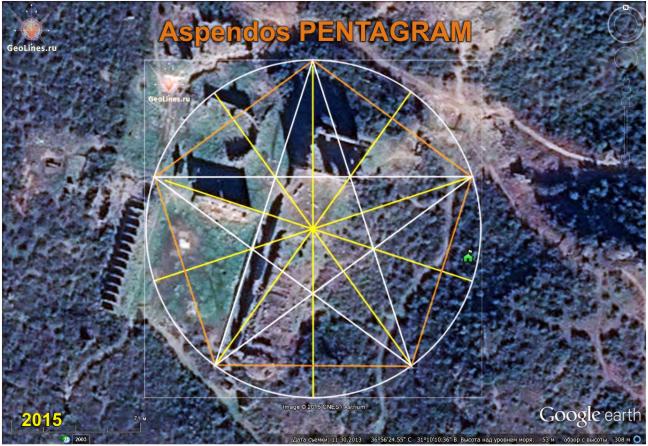 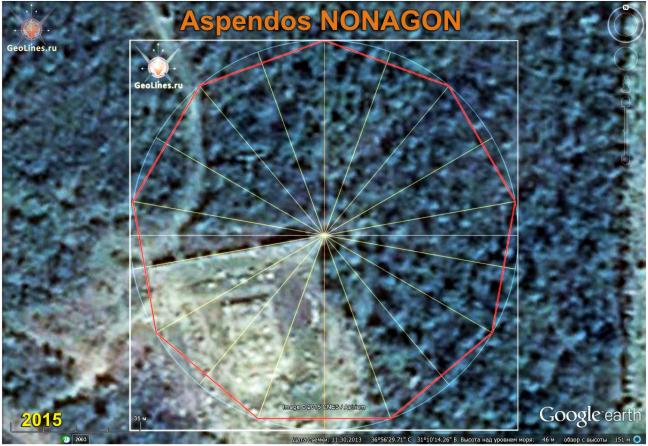
|
|
In many countries, peoples built the beautiful capitals, then moved them, changed their names, or were not able to defend against the enemy. The capitals have been destroyed and even forgotten. But Ayutthaya the ancient city, majestic and mysterious ancient capital of Siam has not forgotten. On this area for several centuries existed the kingdom of Ayutthaya (by analogy with the city of Ayodhya the birthplace of the God Rama in India). These ruins of the city are included in the UNESCO list of World Heritage sites. And the city was rather big about one million inhabitants, three royal palaces and about 400 churches, three dozen fortified forts. The city was called the "Rome of south-east Asia", which was built in the 14th century.
Many churches in the city are built in accordance with the correct figures and interact with each other. We can say that Ayutthaya is a navigation system under the open sky.
 
|
|
In central China, about 100 kilometers from Mount Xi'an in Shaanxi province there is a complex of giant pyramids, the height of the largest of which is estimated at almost 300 meters, two times higher than Great Pyramid in Giza. According to an ancient Chinese legend, over one hundred pyramids built in this country suggest visiting our planet by aliens from other worlds. Many pyramids are oriented according to correct geometrical figures.
|
 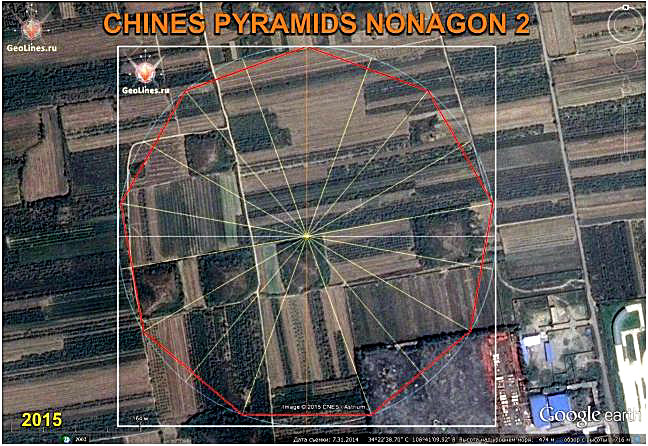 |
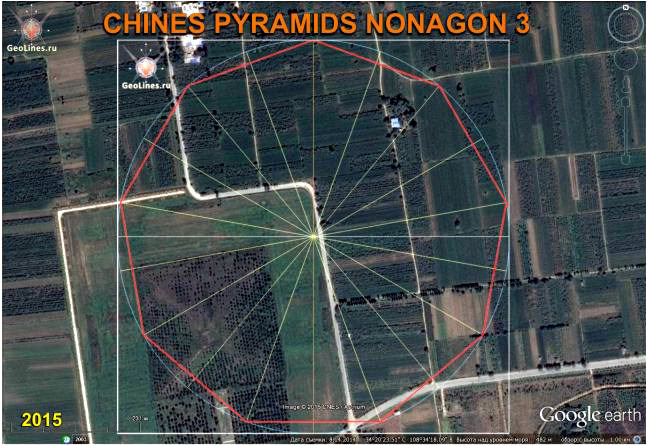  |
|
Babylon is the largest city of ancient Mesopotamia, the capital of the Babylonian kingdom in 19-6 centuries. BC the most important trading and cultural center of southwest Asia. Babylon comes from the Akkadian word "Bab -ily" - "Gates of God". Babylon was built on the place of an ancient Sumerian city of Kadinger the name of which was subsequently transferred to Babylon. The first mention of Babylon found in the inscription of the Akkadian king Shar-Kali-Sharri (23 BC.). In 22 century Babylon was conquered and plundered by Shulgi king of Ur, Sumerian state, subjugated all of Mesopotamia.
The main buildings of Babylon is oriented and planned according to pentagram. The neighboring church is designed and oriented according to hexagram.
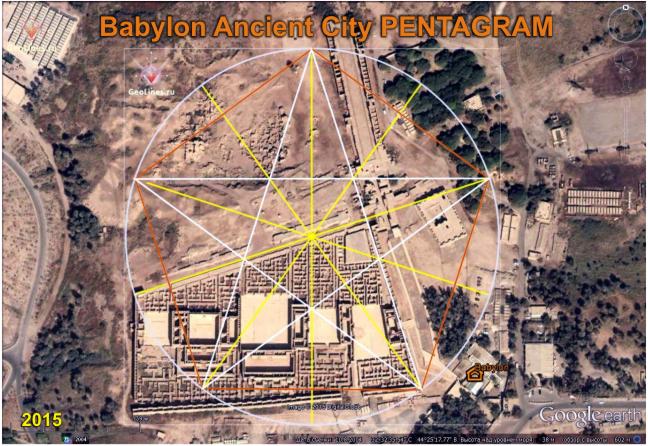 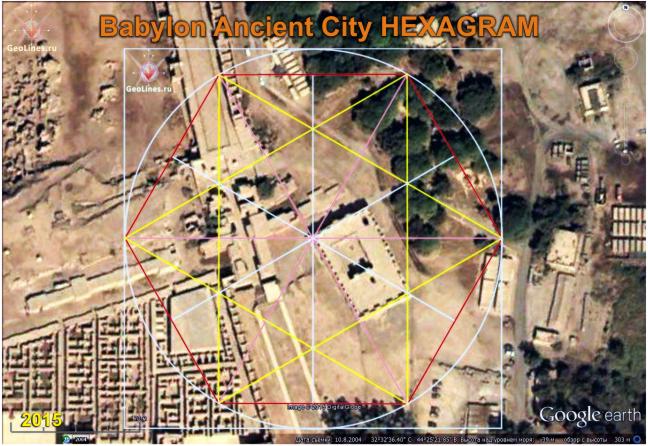
|
|
Ur is one of the most ancient Sumerian cities of Mesopotamia. The origins of the founding of the city go back to the fifth Millennium BC. The heyday of Ur they refer approximately to the beginning of the third Millennium B.C. the so-called Early Dynastic Period (3000 - 2400 BC.) After a period of decline Ur flourished again in controlling of the third dynasty of Ur in the XXI century BC. The founder of this dynasty - Ur-Nammu built a great ziggurat in honor of Nanna the moon-god.
The upper part of the ziggurat is oriented to pentagram and neighboring structures are oriented according to nonagon.
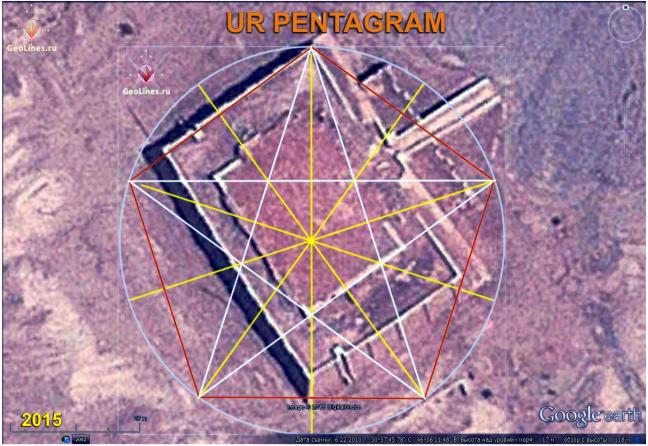 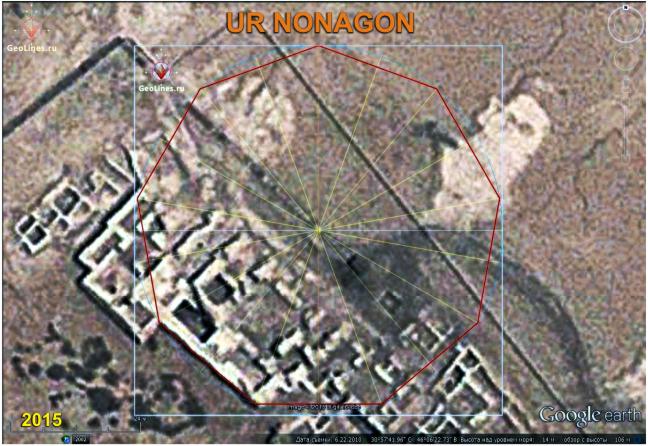
|
|
The complex was built around 1250 BC. by king of Elam Untash-Napirisha in honor of the great god Ishushinaka. Originally the town was called Dur Untash (city Untash), probably it was not actively inhabited.
Around the city were built three concentric walls inside of which was located city proper. Large ziggurat in the inner city was dedicated to the main deity the ziggurat was built on the place of a large flat area. In the center there are 11 small temples of deities.
It was planned to build 22 temple but construction was halted after the death of the king. In the outer parts of the city there is the Royal Palace and the royal funerary palaces.
Directly the ziggurat itself is oriented according to octagon and its sides are the diagonals of the square. Other facilities located around are oriented according to correct figures. |
 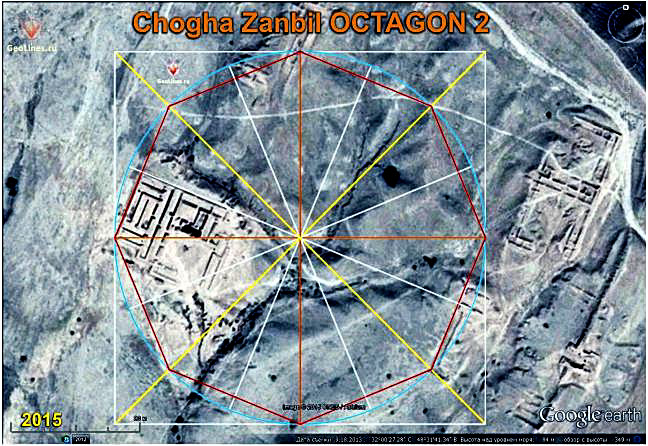 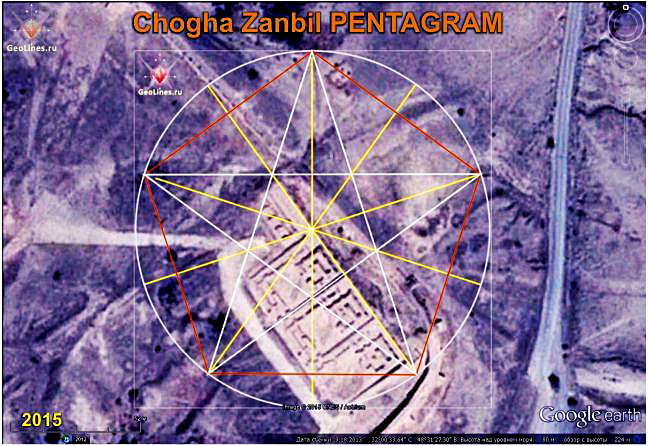 |
|
Besides graves of the kings on the complex territory Naqsh-e Rustam there is a strange and mysterious building - the "Cube of Zoroaster." There are several versions of the purpose of this building. The most plausible and common are two versions. According to the first one under this building there is a tomb of Cyrus the Great. And on the other one here was a ritual space for the storage of fire of Zoroastrians. Cube is located in the western part of Naqshe Rustam and oriented according to pentagram along the azimuth 72°/162°.
|
|
Ebla is an ancient city-state which existed on the territory of northern Syria in the 3rd - beg. 2nd millennium. BC. Up to the 2nd half of 20th century Ebla was known only by name. Excavations of Italian archaeologists (1974-75) under the leadership of Paolo Mattie discovered the ruins of the fortress Able, monuments Able material culture and art (statues, utensils) and a huge cuneiform archives, including business documents and literary works (myths and so on).
About 20% of texts written in the language "Ebla" close to prasemitic. Opening of Ebla showed that this area of ??the original dwelling had highly developed urban civilization.
Some buildings and temple Ebla are oriented according to pentagram along the azimuth of 18°.
|
|
Hattusa is the ancient capital of the Hittite Empire is located in 150 km from Ankara in Turkey. The ruins were discovered in 1834. Here were found the remains of walls, palace, temples, an aqueduct, residential and other buildings, and also a rich bogaschewsky archive. Hattusa is known since the second half of the III millennium BC.
Appointment of the most mysterious construction of Hattusa - ramp pyramidal-shape under which is laid a stone tunnel, it becomes clear if we look at it in terms of navigation and present it as a basic reference, which marks the 40th latitude. Ramp is located exactly in the direction of East - West along the 40th latitude with an accuracy of seconds.
Among numerous constructions of Hattusa, or rather of their remains there are buildings and temples oriented at right angles.
|
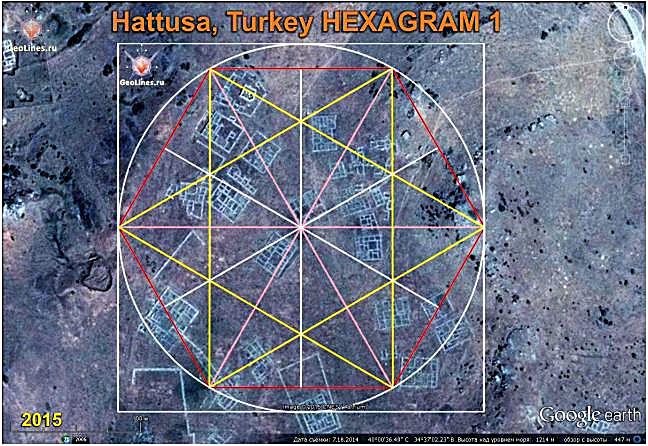 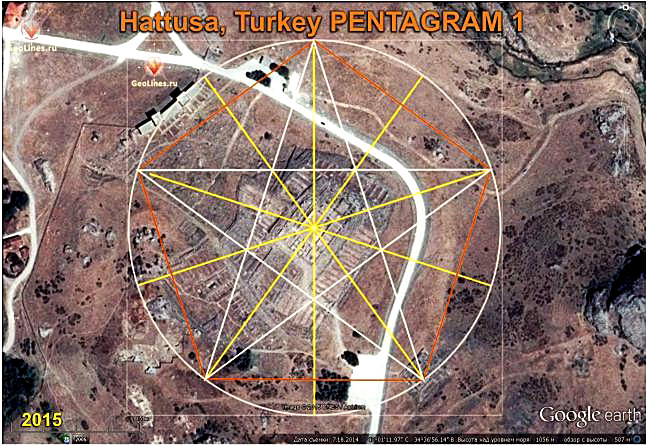 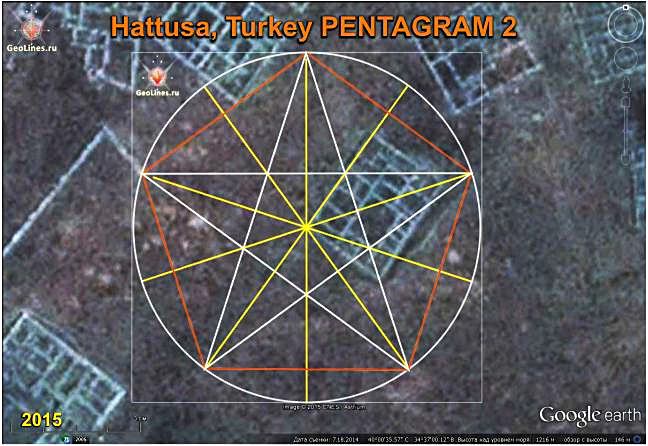 |
|
Slender columns, ancient bridges lined with stones of different periods (Hellenistic and Roman), the acoustics of the restored theater, dilapidated, but full of dignity and grace temples to the Gods Zeus, Dionysus, Artemis, all this is Jerash one of the oldest cities in the Middle East. Almost five centuries of Roman and the Byzantines reign contributed to the flourishing of the city. But the city fell not from the battles of people but from powerful the disaster. Earthquake in 746 BC. completely destroyed the city and torrents of mud and earth turned Jerash in the "Pompeii of the East".
The temples complex to the east of the amphitheater is oriented according to pentagram along the azimuth of 54°. Also it is interesting that at the point of Jerash, the direction to the West will be with an accuracy of half a degree the direction to the Easter Island and the direction to the East will be the exact direction to Angkor.
|
|
Mecca is the holy city for all Muslims. The date of foundation of the city is unknown, first it mentioned by Ptolemy as Makoraba. Here was born the Prophet of Allah Muhammad. In 630, strengthening their position, Muslims Medina community, led by the Prophet Muhammad entered Mecca, the city surrendered without a fight the people recognized Islam. Mecca with the holy Kaaba was transformed into a religious center and Muslims began to pray facing Mecca, wherever they could be.
In the center of Mecca there is the Mosque of Al-Haram on the square of which is located ??the sacred Kaaba stone oriented according to hexagram. |
|
Honor of Palmyra opening history ascribes to Italian Pietro della Balle. In the XVII century travelers got to Palmyra for a long time and with great difficulties but when they returned to Europe nobody simply did not believe them about the city in the Syrian desert. Could such be? Since ancient times, the locals called and still call Palmyra "Tadmor" that means " to be a wonderful,." The city seems to continue the surrounding nature and therefore its beauty is natural and quiet. From the valley of yellow sand surrounded with purple hills rise columns with curly capitals like palm trees crowns.
Until our time Palmyra remained unreconstructed and therefore golden, sun-warmed walls of its buildings, still decorate carved leaves and bunches of grapes, camels and donkeys.
Orientation of the most Palmyra’s buildings one way or another, is connected with the angles of regular geometric shapes. |
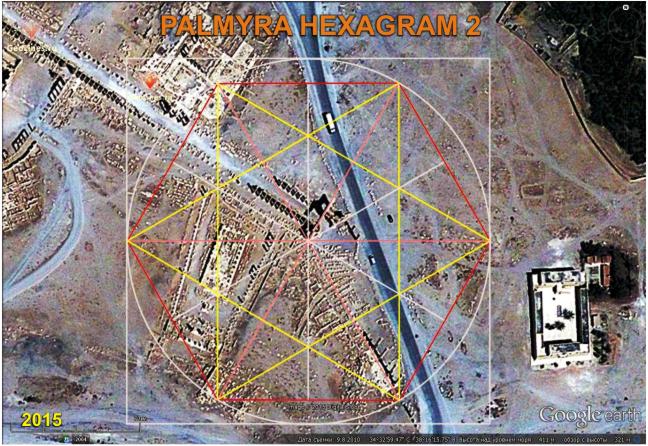 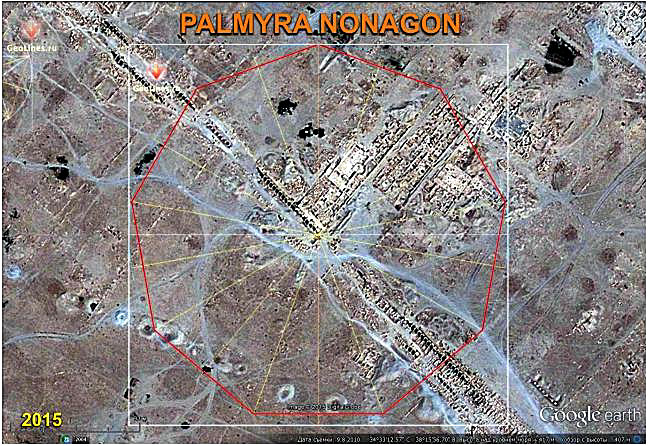  |
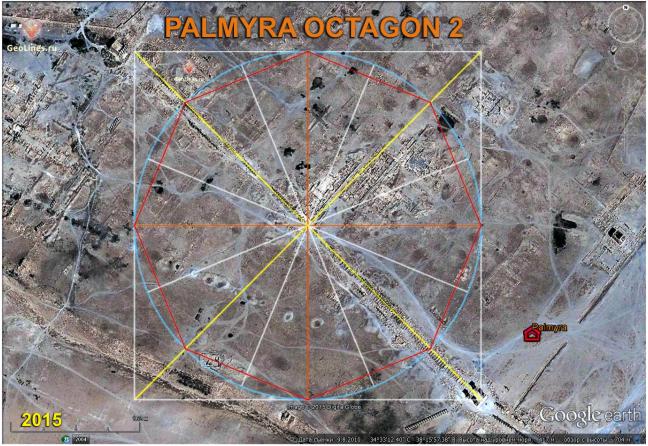 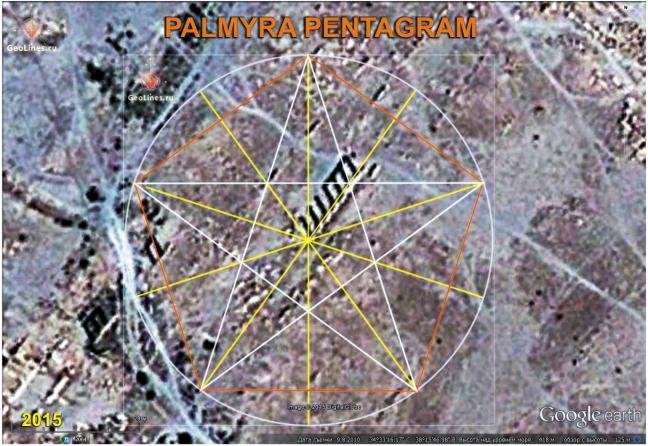 |
|
Pasargadae is an ancient city located in 120 km to the north from Shiraz and only in 50 km from the famous Persepolis. Once there was the palace of the Persian king Cyrus and here Cyrus was buried. At present, very little of Pasargadae that survived. About four disparate points there are traces of antiquity in the form of fallen columns or foundation of mighty fortress.
Though all these things will be much more relevant for professional archaeologists. The main value of Pasargadae is the tomb of King Cyrus located right at the entrance. As stated in guidebooks, when Alexander the Great took Persepolis, he went to the tomb of Cyrus defeated him in Pasargadae.
Temple in Pasargadae is designed and oriented according to hexagram along the azimuth 120°. |
|
Persepolis is ancient Persian city which appeared in the VI-V centuries BC. the capital of the great Achaemenid Empire. In Persepolis remained remnants of the palace complex and places of worships. Today the ruins of Persepolis represent a huge palace complex with an area of ??135,000 square meters on a high platform.
As well as in other ancient cities in Persepolis there are a structures oriented according to the right angles. |
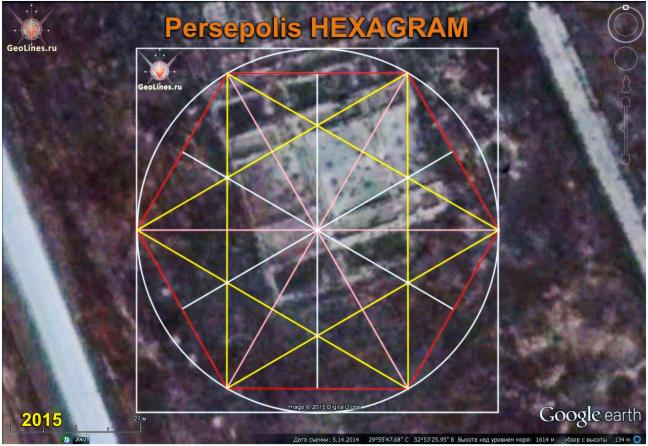  |
|
Side in Turkey was founded by Greek sailors in the VII century BC. The city's name is translated from the ancient Anatolian as "garnet", which was a symbol of fertility in those days. From a small settlement Side grew in a large shopping port city of Turkey, which was the center of the slave trade and pirate base. Side serially conquered by Alexander the Great, the Ptolemies and Seleucids. Side subsequently became the part of Pergamon Kingdom.
Amphitheatre in Side and adjacent buildings are oriented along the azimuth of 60° and correspond to hexagram. |
|
Susa is one of the oldest cities in the world, based by estimates about 4000 BC, the first traces of habitation date back to 7000 BC Pottery with paintings found in excavations date back to 5000 BC. In the V century BC it was rich capital of Suziany, originally the residence of the Elamite then Persian kings (Achaemenid). In the history of Susa became known as the capital of the state of Elam. The city is mentioned in the earlier Sumerian documents. Susa is repeatedly mentioned in the Old Testament, especially in the Ketuvim (Scripture), and also in the book of Esther Nehemiah and the book of prophet Daniel.
The main temple in Susa is oriented along the azimuth of 20° and corresponds to nonagon. |
|
Gaochang is an ancient military colony founded by Hun rulers in I. BC in Turpan cavity in 30 km from the modern Turfan. One of the first centers of Buddhism on the territory of China. The ruins first were investigated in the early XX century by Albert von Lecoq. Since 439 citadel of the last the rulers of Northern Liang State. In 460 it was taken by Zhuzhansky troops which inhabited oasis by immigrants from China. Several times it passed from hand to hand between Dinlinams and Turcuts.
Huge remnant of ancient wall on the fortress territory still denotes the direction of 72°. |
|
Mention of Lhasa as about the formed administrative center dates back to the 6th century. In the seventh century King Gampo Srontszen officially moves to Lhasa the capital of Tibet, he puts the palace in the place where subsequently appeared Potala. At the same time, built the Jokhang Temples and Ramoche, where were placed Buddhist relics brought wives of Srontszen Gampo. These temples are still popular objects of worship.
Subsequently, Lhasa lost its status as the capital and only in 1642 as directed by the Fifth Dalai Lama returned it and keeps until now.
The main facade of Potala is oriented along the azimuth 80° and corresponds to nonagon as well as freestanding temple located to the south. |
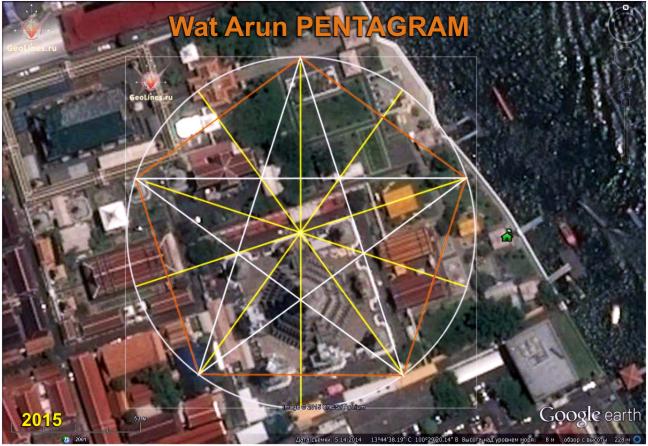 Wat Arun Wat Arun
Wat Arun - Temple of Dawn is one of the most famous and revered in Bangkok with 79-meter-high pagoda. This luxurious complex is named in honor of dawn God Aruna. During the reign of Prince Thaksin (1767-1782) Wat Arun was the chief royal monastery in the country. During the reign of Kings Rama I and Rama II, the monastery was significantly expanded. Central Prang (stupa) built in the XVIII century, is still considered the highest one in Thailand. It symbolizes Mount Meru, and it’s the tiers is multiplicity of worlds. The whole complex is oriented according to pentagram.
|
Wat Pakung Wat Worachatha Ram
Another Thai temple Wat Pakung is oriented according to nonagon along the azimuth of 100°. |
 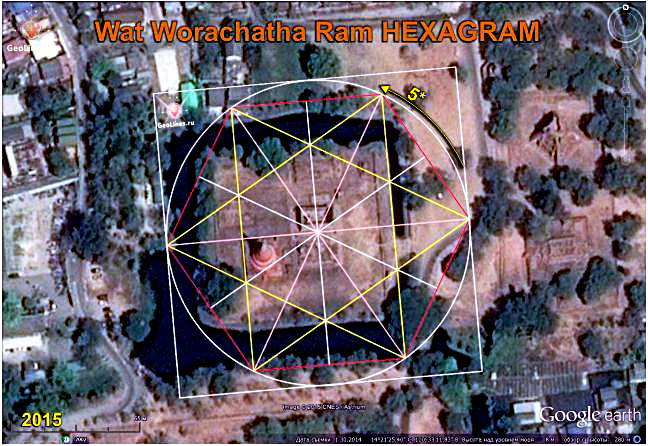 |
|
AFRICA 1 AFRICA 2 ASIA 1 ASIA 2 ЕВРОПА NORTH AMERICA 1 NORTH AMERICA 2 SOUTH AMERICA OCEANIA AND ISLANDS |





